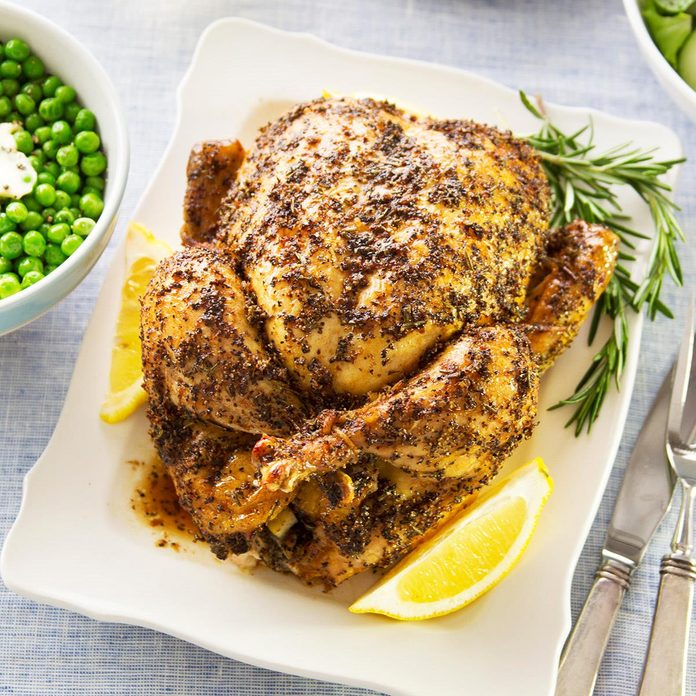When it comes to Sunday suppers, roast chicken is one of the classics. And for a good reason, too. These birds are the perfect cheap dinner idea, and they’re versatile enough that you can repurpose the chicken leftovers all week long.
Learning how to roast chicken sounds intimidating, but you don’t need to fret. The Taste of Home Test Kitchen has the tips and tricks you need to make roast chicken taste just as good as Mom’s. The result is a juicy, tender, golden brown roast that’s perfect when paired with roasted vegetables and a crisp side salad. It’s a dinner worthy of a special occasion, but it also works as a weeknight dinner.
Roast Chicken Ingredients
- Lemons
- Rosemary sprigs
- Roasting chicken
- Olive oil
- Fresh rosemary
- Ground pepper
- Kosher salt
Directions
Step 1: Prep the chicken
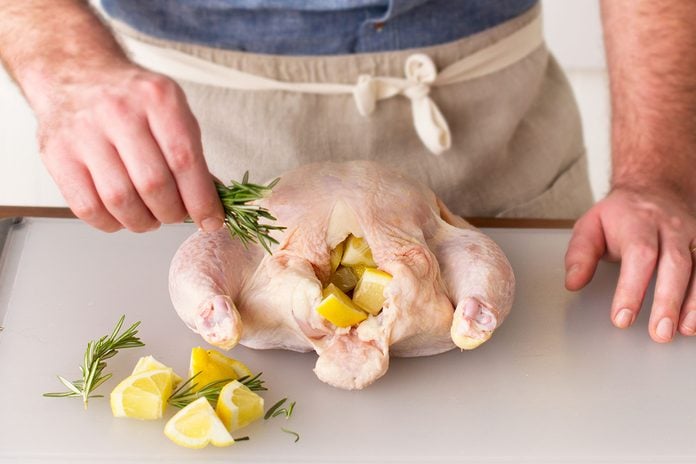
Before you do anything, take the bird from its packaging and pat it dry with paper towels. The drier the skin, the crispier and more delicious it will be.
Once the chicken is dry, stuff it with aromatics—the herbs and citrus. Start by zesting two to three lemons. Set that zest aside for later. Then chop up the lemons into medium-sized chunks. Place the lemon wedges and the rosemary sprigs inside the cavity of the chicken (make sure you remove the bag of giblets.)
Step 2: Truss the chicken
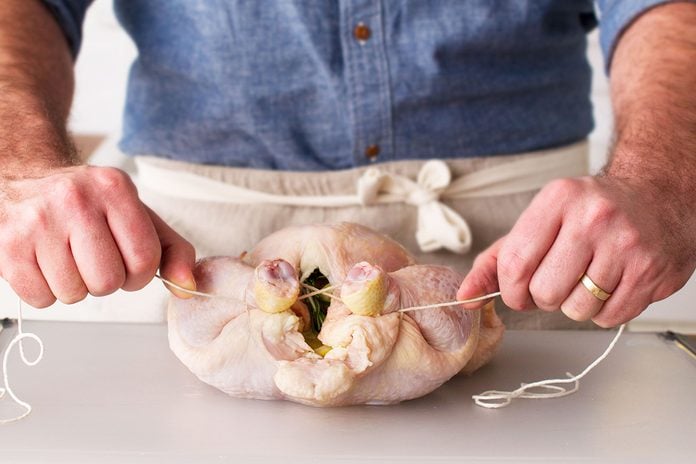
Trussing is a fancy-sounding word for tying up the bird before it roasts. This keeps the chicken in a compact and uniform shape, allowing it to cook evenly. If this is a new technique for you, here’s how to truss a chicken:
- Grab a spool of butcher’s twine.
- Place the bird breast-side up.
- Place a long piece of string underneath the legs and tail, pulling it so it has an equal length on each side.
- Form a loose figure eight around the legs, pulling the string up around the tops of the legs before crisscrossing it below the ankles.
- Pull the string tight to squeeze the legs together. Then loop the string back to the top of the ankles.
- Crisscross the string near the chicken’s cavity. Pull it up towards the wings, hooking it on either side of the breast.
- Flip the chicken over and tie the string around the wings.
- Trim off any excess twine.
Step 3: Pick the right pan
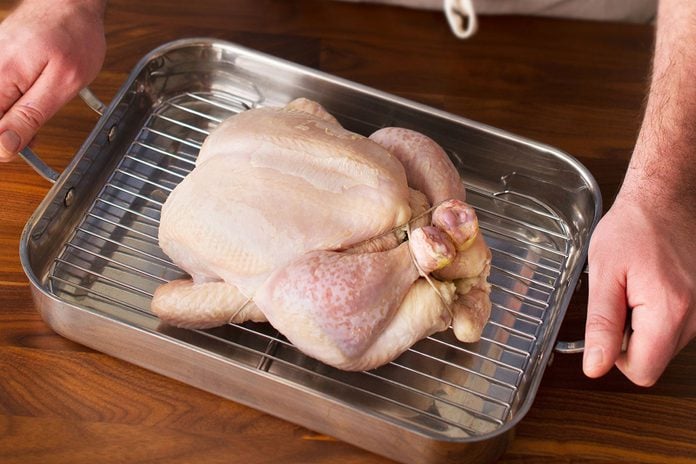
Most roast chicken recipes call for a shallow roasting pan fitted with a rack to elevate the bird. This ensures that hot air will circulate around the chicken, giving every inch a crispy, golden brown bake. For this recipe, you’ll need a small (14-inch) roasting pan with sides about 3 inches tall. We like using stainless-steel roasting pans because they’re lightweight and don’t react to acidic ingredients.
Place your trussed chicken, breast-side up, on a roasting rack in preparation for the next step.
Step 4: Season the chicken
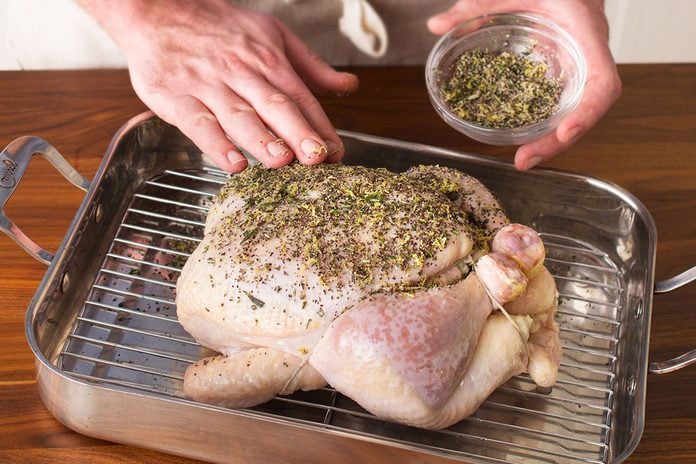
Don’t be afraid of seasoning! This whole chicken requires a lot of flavor to permeate all the meat. Our Test Kitchen experts have a few tips for seasoning meat like a pro:
- Use kosher salt instead of table salt. It has a coarser grain, so you can cover more surface area of the chicken without creating an overly salty flavor.
- Don’t skimp on the salt. Use about one teaspoon of kosher salt per pound of meat.
- Season in advance. Salt pulls moisture away from the surface, drying out the skin and helping it crisp up to perfection. Let the chicken rest for at least 30 minutes, or as long as 12 hours if you have the time.
In this recipe, the chicken gets a good dose of seasoning from the lemons and rosemary inside the cavity. That doesn’t mean we can skip seasoning the outside, though. Start by brushing the outside of the chicken with oil. We use olive oil in this recipe, but you can substitute vegetable or grapeseed oil.
In a small dish, toss together the reserved lemon zest, minced rosemary, salt and pepper. Pat this mixture all over the chicken, making sure to get all the sides and nooks and crannies.
Step 5: Roast the chicken
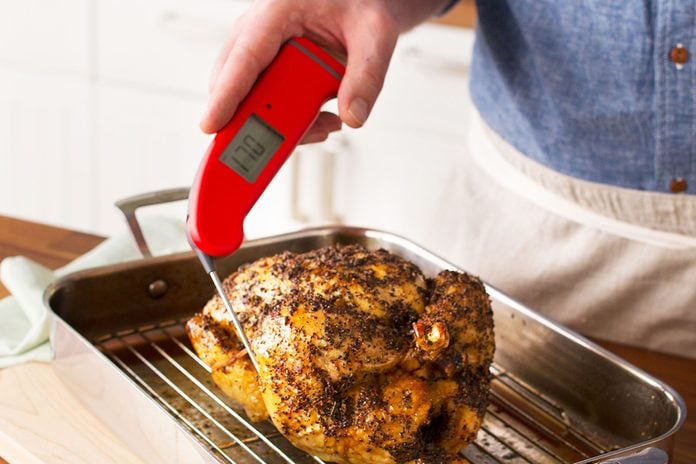
Let’s get roasting! Bake the bird, uncovered, in a 350°F oven for at least two hours (it may take up to two hours and 45 minutes if you have a larger bird). As it cooks, baste the chicken occasionally with the drippings that collect at the bottom of the pan. If you don’t have a baster, you can use a spoon to scoop the drippings and pour them over the top of the chicken.
When done, the internal temperature should read 165º in the breast or 175º in the thigh. To get the most accurate reading, insert an instant-read meat thermometer into the thickest part of the meat (being careful not to touch the bone).
Test Kitchen Tip: If the chicken is browning too quickly, cover it loosely with aluminum foil.
Step 6: Let the chicken rest
Once the chicken has finished cooking, let it stand at room temperature for at least 15 minutes before carving. This cooling period allows the proteins to relax and let moisture in, giving you a juicy, tender bird. Tent with foil to keep the chicken warm.
Step 7: Carve the roast chicken
Snip off the string and discard the lemons and rosemary from the chicken cavity. Then get carving—it’s easier than you think! Here’s how to carve a chicken:
- Tilt the chicken over the roasting pan to empty any excess juices from the cavity (and use them to make gravy).
- Place the chicken breast-side up on a cutting board, positioning it so the wings are facing away from you at the top of the cutting board.
- Slice the skin between the leg and body to expose the joint.
- Pull the leg away from the body and slice through the hip joint, removing the thigh and drumstick in one piece.
- Flip the leg over to get a better view of where the two pieces meet. Separate the drumstick from the thigh by slicing along the drumstick curve until you reach the joint.
- Repeat these steps to remove the second thigh and drumstick.
- Loosen the breast meat by making a long, horizontal cut from the top of the wing to the point where the leg used to meet the breast.
- Remove the breast meat by making a deep, vertical cut along the breastbone. Then cut in an angled, downward motion underneath the breast towards the horizontal cut.
- Repeat these steps to remove the second breast.
- Finish by pulling the wing away from the body and cutting through the joint. Remove the wing tip, if desired.
Roast Chicken Variations
We love the combination of lemon and rosemary in this recipe, but if you want to switch things up, here are some other ways to season a roast chicken:
- Balsamic roast chicken: Combine 2 tablespoons of minced fresh rosemary, 3 minced garlic cloves, 1 teaspoon of salt and 1 teaspoon of pepper in a small bowl, then rub the mix under the skin of the chicken. Then, combine 1/2 cup of dry red wine and 1/2 cup of balsamic vinegar in a bowl before pouring it over the prepared chicken. Roast the chicken as directed above.
- Glazed roast chicken: In a small saucepan, bring 1 cup of white wine to a boil; cook until wine is reduced by half, 3 to 4 minutes. Stir in 1 cup of apricot preserves and 1 tablespoon of stone-ground mustard, then divide the glaze in half. Sprinkle the chicken with some salt and pepper and then roast the chicken as directed above. After 45 minutes, pour half of the glaze over then chicken, and then baste the chicken with that glaze every so often when roasting. Once done cooking, serve the chicken with the other half of the glaze.
- Lime roast chicken: Combine 1/2 cup of Dijon mustard, 1/4 cup of lime juice, 1/4 cup of soy sauce, 2 tablespoons of minced fresh parsley, 2 tablespoons of minced fresh rosemary, 2 tablespoons of minced fresh sage, 2 tablespoons of minced fresh thyme, 1 teaspoon of white pepper and 1 teaspoon of ground nutmeg in a bowl. Reserve 1/4 cup of marinade, then pour the rest in a large shallow dish, add the chicken and toss it until it’s completely covered. Let the chicken marinate for at least four hours. Drain the marinade and stuff the chicken with four limes, cut into wedges, brush with remaining marinade and roast the chicken as directed above.
How to Roast a Chicken with Vegetables
Roasting chicken on a bed of vegetables is an ideal way to create a flavorful vegetable side! The chicken juices will drip onto the veggies as they cook, seasoning them with savory flavor.
Start by choosing the right vegetables. You’re looking for ones that can stand up to the chicken’s long cook time. Potatoes, root vegetables or winter squash work really well, but you can also use items like onions or celery if they’re cut into large pieces.
Then, toss the vegetables with a little oil, salt and the seasonings of your choice. Place them in a single layer on the bottom of a roasting pan or sheet pan. If the pan has a rack, you can place the chicken on the rack before putting it on top of the vegetables. You can also skip the rack, as the veggies will keep the chicken elevated from the pan’s bottom.
Cook the chicken according to the recipe above, being sure the chicken is cooked to a safe temperature before tasting the vegetables.
How to Store Roast Chicken
A cooked chicken will last three to four days in the refrigerator. It’s best to store chicken in an airtight container or sealed bag. Wrapping it in aluminum foil will work in a pinch, but exposure to air will dry out the chicken and ruin its flavor.
How to Freeze Roast Chicken
If you can’t eat all the leftovers within a few days, the freezer is your best bet. When the chicken is completely cooled, place it in an airtight container or freezer-safe bag, squeezing out as much air as possible. Freeze the chicken for up to four months. Thaw it in the refrigerator before reheating it.
Roast Chicken Tips
Do you cover a chicken when roasting?
We generally like to roast our chicken uncovered so the skin crisps up and turns an appealing golden brown. If the chicken starts to get too dark before it reaches the proper internal temperature, tent a piece of foil over the top to protect the skin from burning.
What’s the best pan to roast a chicken in?
If you have one, a roasting pan is the way to go. It’s basically an oversized casserole dish with a rack, which promotes airflow around the chicken to help it cook evenly. Don’t worry if you don’t have one; you can also roast chicken in a Dutch oven, a rimmed baking sheet, a casserole dish or a cast-iron skillet. Or, take the chicken outside and try one of these methods for cooking a chicken on the grill.
What can I use if I don’t have a roasting rack?
If you don’t have a roasting rack, it’s easy to improvise. Prop your chicken up on a base of crumpled aluminum foil, or layer the bottom of a sturdy pan with coarsely chopped veggies like potatoes, carrots and onions. This elevates the chicken—just like a rack. Plus you get a built-in side dish!
How do you keep chicken from drying out?
Roasted chicken will taste dry when it loses too much moisture, but that’s an easy condition to prevent. It all starts with salt. Salting the chicken creates a dry brine when combined with the meat’s natural juices. It only needs 30 minutes (or as long as 12 hours) to create a protective layer. As a bonus, salt also seasons the bird, making it more flavorful.
You’ll also want to avoid overcooking the chicken. Meat loses moisture as it cooks, and no amount of brine can help you. Use a meat thermometer to measure when the chicken reaches the ideal temperature: 165ºF for the breast, or 175ºF in the thickest part of the thigh.
How can I check to see if the chicken is done without a thermometer?
The only way to be 100% sure that your chicken is cooked through is to use a meat thermometer.
That said, you can try cutting into the thickest part of the chicken. If the meat is completely white and the juices run clear, the chicken should be done cooking. This isn’t the best method of checking the chicken’s doneness because it releases the chicken juices, making your bird dry.
How long do you roast a chicken per pound?
It takes about 20 to 27 minutes per pound to roast a chicken at 350°. Since that’s a large range of time, the best way to make sure the chicken is cooked through, without overcooking it, is to use a meat thermometer to check its temperature.




















